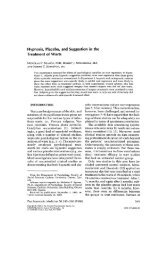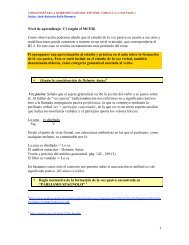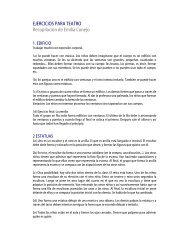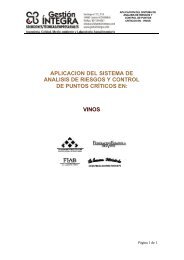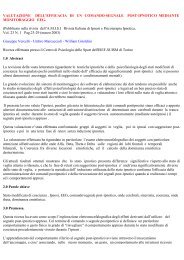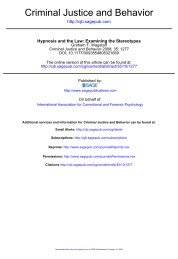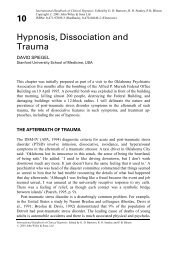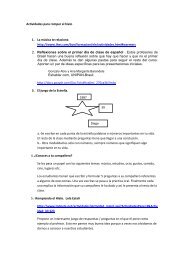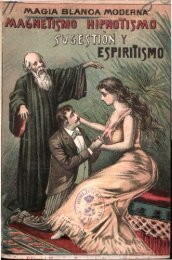Orne, M.T. The use and misuse of hypnosis in court. International ...
Orne, M.T. The use and misuse of hypnosis in court. International ...
Orne, M.T. The use and misuse of hypnosis in court. International ...
You also want an ePaper? Increase the reach of your titles
YUMPU automatically turns print PDFs into web optimized ePapers that Google loves.
<strong>Orne</strong> 1979 IJCEHhttp://www.sas.upenn.edu/psych/history/orne/orneijceh19794311341.html15 de 23 19/03/2012 17:24331 USE AND MISUSE OF HYPNOSIS IN COURTwould be th<strong>in</strong>k<strong>in</strong>g about tell<strong>in</strong>g the truth, how good it would feel to tell the truth, <strong>and</strong> that she was go<strong>in</strong>g totell the truth. With<strong>in</strong> a week after the session, the sister called the police <strong>and</strong> told them how the defendanthad <strong>of</strong>ten choked her, that he seemed to enjoy it, <strong>and</strong> that one time shortly after the murder he waschok<strong>in</strong>g her <strong>and</strong> said someth<strong>in</strong>g to the effect, "If you don't behave, the same th<strong>in</strong>g can happen to you thathappened to Sweetie Pie." When she asked whether he had killed "Sweetie Pie," he allegedly broke downcry<strong>in</strong>g <strong>and</strong> said that he had not <strong>in</strong>tended to but admitted that he did.<strong>The</strong> case aga<strong>in</strong>st the defendant was primarily based upon the sister's hearsay testimony which becameavailable shortly after the hypnotic session. After a lengthy hear<strong>in</strong>g, the <strong>court</strong> ruled that as a matter <strong>of</strong> lawshe could not testify before a jury beca<strong>use</strong>, thanks to the hypnotic session, the presumed memory waslikely to have been created rather than remembered. It is unlikely that anyone will ever know for certa<strong>in</strong>whether the defendant was or was not responsible for the murder. <strong>The</strong>re was no doubt <strong>in</strong> the sister's m<strong>in</strong>d,however, as to the k<strong>in</strong>d <strong>of</strong> memory which was wanted, <strong>and</strong> the sister was amply motivated to testifyaga<strong>in</strong>st the defendant. She had cont<strong>in</strong>ued to live with the defendant, supposedly know<strong>in</strong>g that he was amurderer, for many months until he rejected her. Consequently, her testimony would have been totallydiscounted if it had not come after the hypnotic session. <strong>The</strong> <strong>court</strong> recognized the danger <strong>of</strong> permitt<strong>in</strong>g<strong>hypnosis</strong> to be <strong>use</strong>d <strong>in</strong> a context where it is more likely to create a memory than to refresh it.Whereas <strong>in</strong> the first case the identity <strong>of</strong> the defendant became known to the victim dur<strong>in</strong>g a pretrialhear<strong>in</strong>g, <strong>and</strong> <strong>in</strong> the second case the nature <strong>of</strong> the memory was shaped by conversations with the police<strong>of</strong>ficers, with the sister, <strong>and</strong> particularly by the way the hypnotic session was conducted, it is equallypossible for the suggestion about what to recall to come from entirely different sources unrelated to <strong>and</strong>long before <strong>hypnosis</strong>. For example, <strong>in</strong> the M<strong>in</strong>nesota case <strong>of</strong> State v. Mack (1979), a physician <strong>in</strong>sist<strong>in</strong>gthat a laceration must have been made by a knife led to a total reorganization <strong>of</strong> an apparent victim'smemory about how she had acquired an <strong>in</strong>ternal wound. In other cases, the media have provided thecritical <strong>in</strong>formation, while <strong>in</strong> still others, the manner <strong>in</strong> which a l<strong>in</strong>eup was conducted facilitated thecreation <strong>of</strong> "memories" at hypnotic sessions conducted at a later date (e.g., State v. Peterson, 1979).In addition to crim<strong>in</strong>al cases, it is not uncommon to f<strong>in</strong>d someth<strong>in</strong>g <strong>of</strong> this k<strong>in</strong>d <strong>in</strong> civil cases where an<strong>in</strong>dividual is helped by <strong>hypnosis</strong> to remember details <strong>of</strong> an accident he had been unable to recallpreviously. By the time <strong>hypnosis</strong> is carried out, it is generally clear to the subject which <strong>of</strong> the possibleevents that could have occurred would be most332 MARTIN T. ORNEhelpful to his case. Though it is possible that accurate <strong>in</strong>formation is recovered, the important effects thatmotivation can exert on memory--hypnotically enhanced or otherwise--must be taken <strong>in</strong>to account <strong>in</strong>assess<strong>in</strong>g the "memories" that are obta<strong>in</strong>ed.To Affirm the Reliability <strong>of</strong> the Witness's Statement or to Create an Apparently Reliable WitnessMany witnesses are unreliable <strong>in</strong> the sense that they tell somewhat different stories each time they areasked to tell what had occurred. <strong>The</strong>se differences may relate to important details <strong>of</strong> the crime. <strong>The</strong>adversary system upon which Anglo-Saxon justice is based is particularly effective <strong>in</strong> unmask<strong>in</strong>g theunreliability <strong>of</strong> witnesses by means <strong>of</strong> cross-exam<strong>in</strong>ation before a jury.<strong>The</strong> effect <strong>of</strong> hypnotiz<strong>in</strong>g witnesses <strong>of</strong> this k<strong>in</strong>d, presumably to help refresh their memories, is generallydramatic. Even if the subject is not particularly responsive to <strong>hypnosis</strong>, review<strong>in</strong>g the events <strong>in</strong> thehypnotic context <strong>and</strong> hav<strong>in</strong>g the memories legitimized by the hypnotist generally fixes one particularversion <strong>of</strong> the testimony <strong>in</strong> the witness's m<strong>in</strong>d which is then faithfully <strong>and</strong> reliably reproduced every time.In these cases, <strong>hypnosis</strong> does not serve to produce any new <strong>in</strong>formation, but the procedure can bolster awitness whose credibility would easily have been destroyed by cross-exam<strong>in</strong>ation but who now becomes



